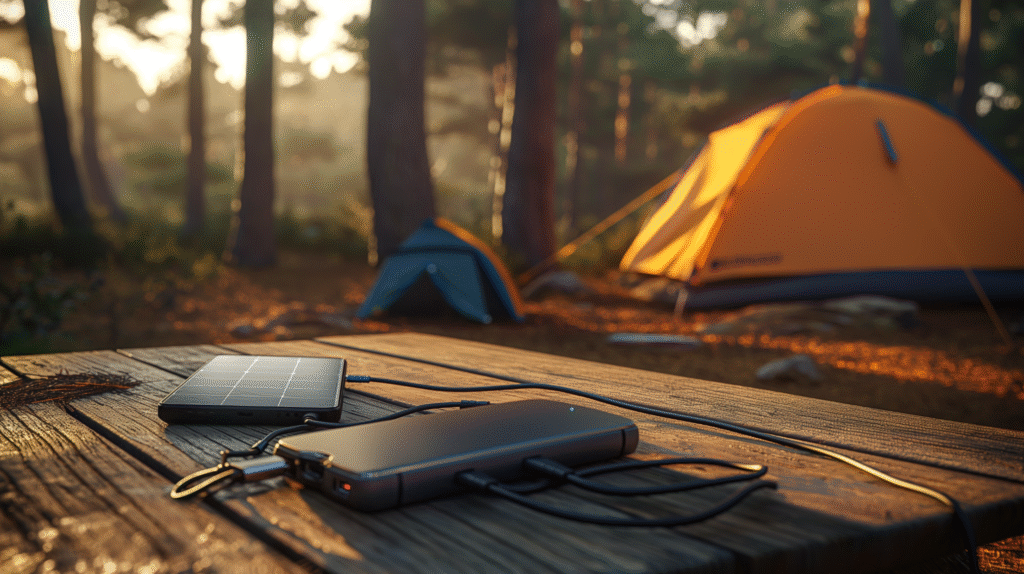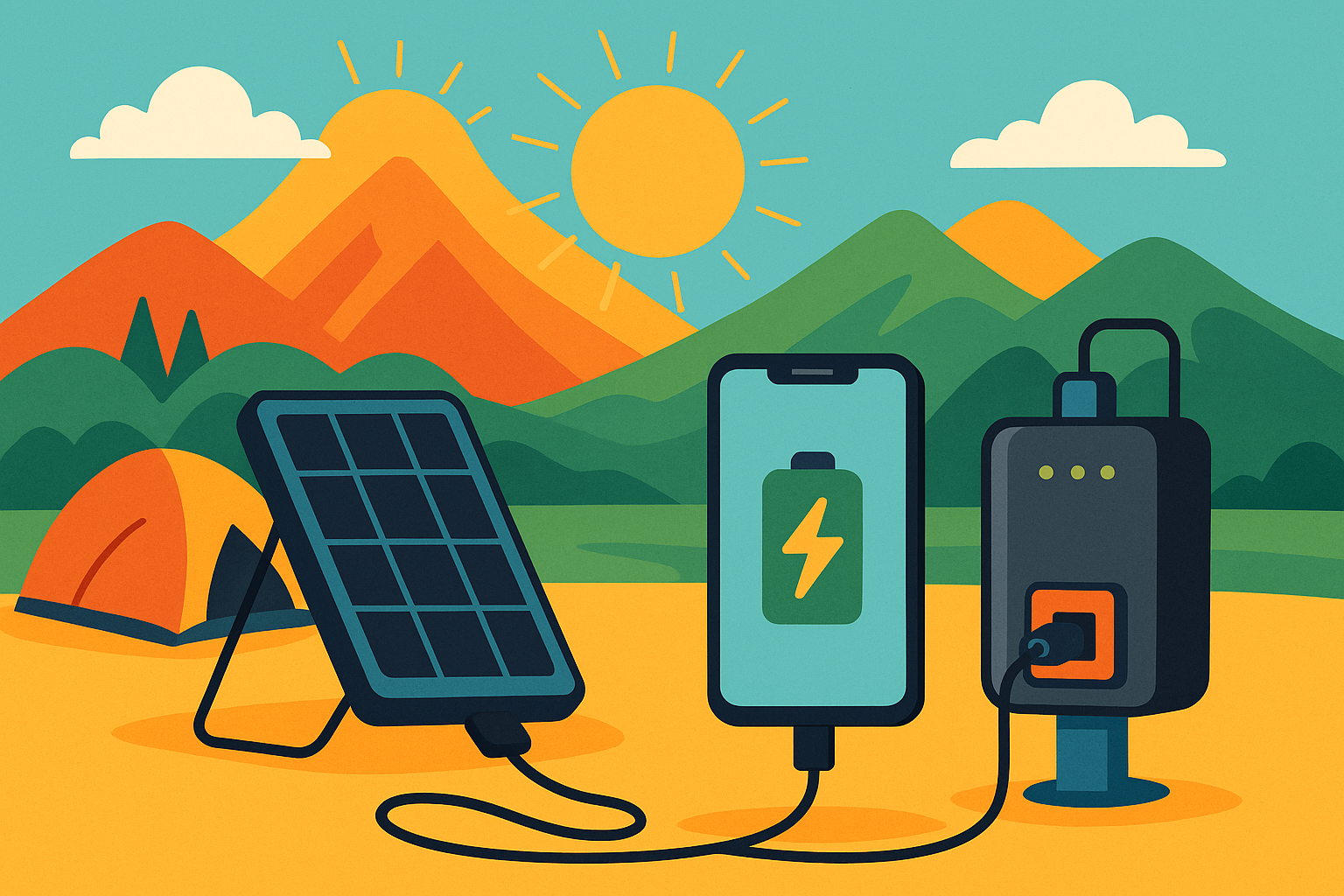Power Banks 101: Solar vs Regular Power Bank for Camping
This solar vs regular power bank for camping comparison explains the strengths and weaknesses of each type so you can decide which one suits your adventure.
Power Banks 101: Solar vs Regular Power Bank for Camping
Charging Methods: Sunlight vs. Wall Outlet
Portability & Weight: Packed for Adventure
When packing for a hike, every ounce counts. Traditional power banks come in a huge range of sizes and capacities — from slim, pocket‑sized units for topping up a phone to brick‑sized batteries that can run a laptop. You can choose a model that balances weight and capacity for your needs. Solar power banks add solar panels to this equation, which inevitably increases their footprint and sometimes their weight. Even compact solar banks are generally bulkier than a comparable regular bank because they house fold‑out or built‑in panels. That said, many campers don’t mind the extra size if it means they can harvest free power on the trail. If minimizing weight is your top priority, a lightweight regular power bank may be the better choice; if you value off‑grid independence, a slightly heavier solar bank could be worth the trade‑off.
Capacity & Output Performance
Both solar and conventional power banks use lithium‑ion batteries with capacities rated in milliampere‑hours (mAh). In practice, this number tells you how many smartphone charges you’ll get out of a bank; a 10,000 mAh unit, for example, can usually charge a 2,500 mAh phone about three times. Solar banks come in comparable capacities to regular banks and often include multiple USB ports for charging more than one device at once. The main difference lies in how quickly you can refill that capacity. When connected to the grid via a USB‑C or micro‑USB input, both types charge at similar rates. Using the solar panels, however, adds hours or even days to the process. When evaluating a power bank, look for high‑speed output ports like 2.1 A or 3 A USBs and consider your device needs — a higher current rating means faster charging for phones, cameras or tablets.
Durability & Weather Resistance
Modern power banks are designed to endure outdoor use, with tough plastic or rubberized casings that can withstand bumps and drops. Solar models add a layer of complexity: while their housings are often just as rugged, the photovoltaic panels themselves are vulnerable to scratches and cracks, so you’ll want to pack them carefully. Many solar banks also feature weather‑proof covers over ports and IP ratings that indicate resistance to dust and water — a welcome feature for unpredictable outdoor conditions. Conventional power banks can be just as sturdy, and some manufacturers offer waterproof or shock‑proof versions designed specifically for camping. Before you buy, check product descriptions for weather resistance ratings and choose a design that matches the environments you plan to explore.
Environmental Impact & Sustainability
Choosing a solar bank is appealing if you want to minimize your carbon footprint, since it lets you capture renewable energy during your trip rather than relying solely on electricity generated from fossil fuels. Over the long term, this can reduce the number of times you plug into the grid and lower your overall impact. That said, solar cells and lithium‑ion batteries still require energy and resources to manufacture, and they eventually wear out. Regular power banks draw all their energy from the grid, and unless you charge them with renewable electricity, their use indirectly contributes to greenhouse gas emissions. No matter which type you choose, extend your power bank’s life by avoiding extreme temperatures and recycling it responsibly through an e‑waste program when it reaches the end of its service life.
Cost & Value for Money
Traditional power banks are widely available and relatively inexpensive. You can find reliable models in the 10,000 mAh range for a modest price, and larger capacities cost a bit more but still offer good value per watt‑hour. Solar power banks cost extra because of the integrated panels and weatherproofing. The price premium can be anywhere from 20 percent to double that of a comparable regular bank, depending on brand and features. When weighing costs, think about how often you’ll actually need to harvest solar power. If most of your trips involve access to electricity, a regular bank might deliver better value. If you frequently travel off the grid or want a power backup for emergencies at home, the extra investment in a solar bank could pay off over time.
Pros & Cons: Choosing the Right Power Bank
Here’s a quick breakdown of when each type of power bank shines:
Choose a solar power bank if:
- You expect long stretches without access to electricity.
- You want the freedom to top up your battery with sunlight on the trail.
- A slightly heavier, larger device is acceptable for off-grid independence.
Choose a regular power bank if:
- You have reliable access to wall outlets or vehicle chargers.
- You prioritize faster recharging times and a compact form.
- Budget is a key concern and you don’t need solar functionality.
Conclusion: Solar vs Regular Power Bank for Camping
There’s no single power bank that’s perfect for every camper. Solar models offer the freedom to harvest energy off the grid and are invaluable on extended backcountry trips, but they demand patience and usually weigh a bit more. Traditional power banks excel at fast, reliable recharging when you have access to electricity and tend to be more compact and affordable. By considering your trip length, access to outlets, weight priorities and budget, you can decide which type better supports your adventures. Whichever option you choose, pack enough capacity to keep your essentials running so you can focus on enjoying the great outdoors. Ultimately, the choice between a solar vs regular power bank for camping comes down to your access to outlets, patience for recharging and budget. This solar vs regular power bank for camping guide should make it easier to pick a power solution that supports your adventure. Whichever side you pick in the solar vs regular power bank for camping discussion, make sure it matches your trip conditions. comes down to your access to outlets, patience forenjoying, and budget. This solar vs regular power bank for camping guide should make it easier to pick a power solution that supports your adventure.Whic hever Whichever side you pick in the solar vs regular power bank for camping discussion, make sure it matches your trip conditions.re it matches your trip conditions.


